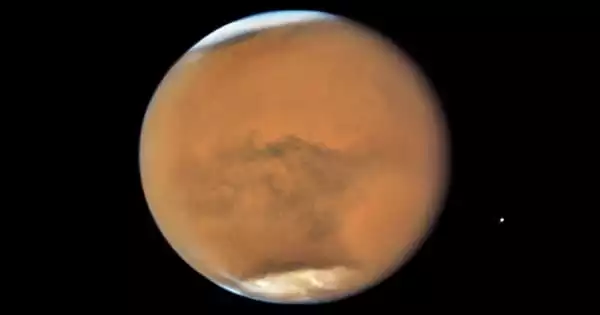Researchers measured the potassium isotope compositions of Martian meteorites to estimate the presence, distribution, and abundance of volatile elements and compounds, including water, on Mars, discovering that Mars has lost more potassium than Earth but retained more potassium than the moon or the asteroid 4-Vesta; the findings suggest that larger rocky planets retain more volatile elements during planetary formation and that Mars and Mars-sized exoplanets are more likely to exist.
Water is required for life on Earth and other planets, and scientists have discovered plenty of evidence of water in Mars’s early history. However, there is currently no liquid water on Mars’s surface. A fundamental reason, according to new research from Washington University in St. Louis, is that Mars is simply too small to hold large amounts of water.
Mars was once water-rich, according to remote sensing studies and analyses of Martian meteorites dating back to the 1980s. NASA’s Viking Orbiter spacecraft, as well as the Curiosity and Perseverance rovers on the ground, have returned stunning images of Martian landscapes dotted with river valleys and flood channels.
Despite this evidence, there is no liquid water on the surface. Many theories have been proposed, including a weakening of Mars’ magnetic field, which could have resulted in the loss of a thick atmosphere. However, a new study published in the Proceedings of the National Academy of Sciences suggests a more fundamental reason why today’s Mars looks so different from Earth’s “blue marble.”
Water is required for life on Earth and other planets, and scientists have discovered plenty of evidence of water in Mars’s early history. However, there is currently no liquid water on Mars’s surface.
Kun Wang
“Mars’ fate was predetermined from the start,” said Kun Wang, senior author of the study and assistant professor of earth and planetary sciences in Arts & Sciences at Washington University. There is most likely a size requirement for rocky planets to retain enough water to support habitability and plate tectonics, with mass greater than that of Mars. Wang and his colleagues used stable isotopes of the element potassium (K) to estimate the presence, distribution, and abundance of volatile elements on various planetary bodies for the new study.
Potassium is a moderately volatile element, but scientists decided to use it as a kind of tracer for more volatile elements and compounds, such as water. This is a relatively new method that differs from previous attempts to determine the amount of volatiles Mars once had using potassium-to-thorium (Th) ratios gathered through remote sensing and chemical analysis. Previously, members of the research team used a potassium tracer method to study the formation of the moon.
Wang and his colleagues measured the potassium isotope compositions of 20 previously confirmed Martian meteorites chosen to be representative of the red planet’s bulk silicate composition.

Using this method, the researchers discovered that Mars lost more potassium and other volatiles during its formation than Earth, but retained more of this volatiles than the moon and asteroid 4-Vesta, both of which are much smaller and drier than Earth and Mars. The researchers discovered a clear relationship between body size and potassium isotopic composition.
“The reason for far lower abundances of volatile elements and their compounds in differentiated planets than in primitive undifferentiated meteorites has long been a question,” said Katharina Lodders, research professor of earth and planetary sciences at Washington University and co-author of the study. “The discovery of the correlation of K isotopic compositions with planet gravity is a novel discovery with important quantitative implications for when and how the differentiated planets received and lost their volatiles.”
“Martian meteorites are the only samples we have to study the chemical makeup of the bulk of Mars,” Wang explained. “Those Martian meteorites have ages ranging from several hundred million to four billion years and have recorded the volatile evolution history of Mars.” We can infer the degree of volatile depletion of bulk planets and make comparisons between different solar system bodies by measuring isotopes of moderately volatile elements like potassium.
“It’s undeniable that there was once liquid water on Mars’s surface,” Wang said. “How much water Mars once had is difficult to quantify through remote sensing and rover studies alone.” “There are numerous models for the bulk water content of Mars. Early Mars was wetter than Earth in some of them. That, we do not believe, was the case.”
The paper’s first author is Zhen Tian, a graduate student in Wang’s laboratory and a McDonnell International Academy Scholar. Piers Koefoed, a postdoctoral research associate, and Hannah Bloom, who graduated from Washington University in 2020, are both co-authors. Wang and Lodders are McDonnell Center for Space Sciences faculty fellows at the university.
The findings have implications for the search for life on planets other than Mars, according to the researchers. The amount of volatiles that a planetary body can retain can be influenced by its proximity to the sun. This star-distance measurement is frequently used in indexes of “habitable zones” around stars.
“This study emphasizes that there is a very limited size range for planets to have just enough but not too much water to develop a habitable surface environment,” said Klaus Mezger, co-author of the study and director of the Center for Space and Habitability at the University of Bern in Switzerland. “These findings will help astronomers search for habitable exoplanets in other solar systems.”
Wang now believes that for planets in habitable zones, planetary size should be more emphasized and routinely considered when determining whether an exoplanet could support life.
“One of the easiest parameters to determine is the size of an exoplanet,” Wang said. “We now know whether an exoplanet is a candidate for life-based on size and mass because size is a first-order determining factor for volatile retention.”
















